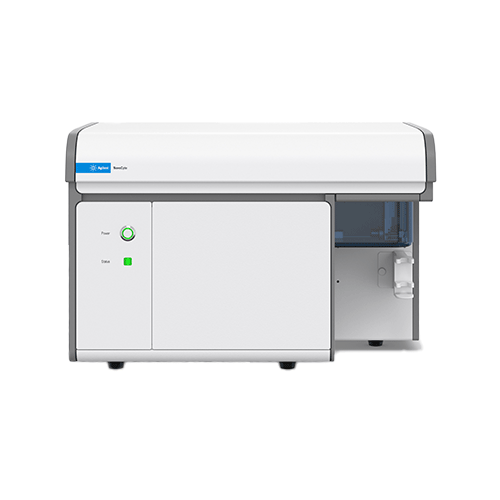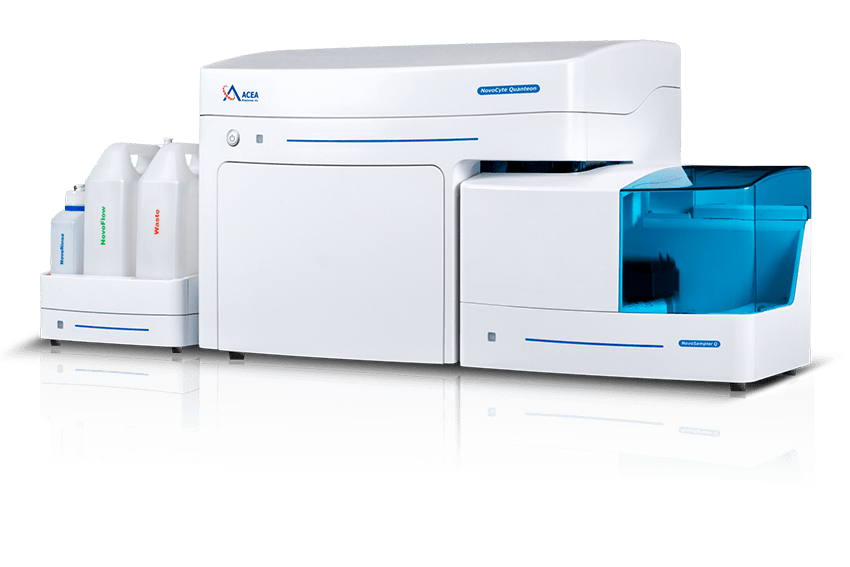NovoCyte Flow Cytometer Systems
Information
Overview
NovoCyte is a high-performance benchtop flow cytometer designed for all levels of users and all types of laboratories. The budget-friendly instrument can detect up to 17 parameters with enhanced sensitivity and resolution. The customizable laser and optical configurations of the NovoCyte offer a high degree of flexibility while providing complex cell analysis capabilities.
The NovoExpress software facilitates easy and intuitive sample acquisition and analysis. Automation of multiple fluidic functions eliminates cumbersome and time consuming procedures. Manual sample handling is minimized by the flexible NovoSampler Pro. The system can automatically analyze samples in single tubes, multi-tube racks, or 24-, 48-, or 96-well plates
- Powerful capabilities with up to 17 parameter detection with enhanced sensitivity and resolution.
- Intuitive, advanced data analysis capabilities for greater usability and automated instrument maintenance functions
- Customizable sampling with 1 to 3 laser options, exchangeable filters, multiple sampling options, and flexible analysis formats
- Enhanced usability with fixed optical alignment, 24-bit detection dynamic ranges and no need for PMT voltage adjustment, accurate volumetric-based cell counting, pressure sensors to monitor fluidic status in real-time, and automatic cleaning and decontamination processes
- NovoExpress software is intuitive and easy to use. Flexible analysis templates and plotting tools save time and increase efficiency in data analysis
-
Models
Product Lasers 349 nm 405 nm 488 nm 561 nm 637 nm Maximum Number of Fluorescence Channels NovoCyte Advanteon** 1 • 7 • 6 2 • • 15 • • 13 • • 11 3 • • • 21 • • • 17 • • 19 NovoCyte Quanteon** 4 • • • • 25 NovoCyte Penteon* 5 • • • • • 30 * RUO: Research use only. Not for use in diagnostic procedures. ** Selected configurations are registered as CE-IVD. -
Applications
Apoptosis Assay
Apoptosis, or programmed cell death, is the process by which cells regulate how they die, activating specific pathways that cause the cell to shrink, condense, and eventually be cleared by phagocytosis. This is in contrast to necrotic cell death where cells die uncontrollably and fall apart, which can lead to detrimental effects such as the activation of an immune response. Therefore, apoptotic cells that die in a very orderly fashion limit disruption of nearby cells and tissue.
There are many ways to measure cell death and distinguish it from apoptosis or necrosis. These assays are easily quantified using the NovoCyte flow cytometer due to automatic compensation settings and a wide dynamic range of fluorescence detection which eliminates the need for any PMT voltage adjustments.Immunophenotyping
Immune status is associated with disease state, treatment efficiency, and response to external stimuli such as vaccines. Immunophenotyping quickly identifies candidate cell types, sub-classes and functions. Monitoring the frequency of numerous immune cell population as well as the differentiation/activation status of specific cell subsets such as monocytes, NK cells, T and B cells is essential as they may influence the immunogenicity of a vaccine and its efficiency. The NovoCyte Flow Cytometer enables simultaneous quantification of multiple leukocytes for better understanding the immune status of patients and surveillance of the immune response to infectious disease.
Specifcity Clone Fluorocrome Purpose CD3 UCHT1 PE-TR (ECD) Lineage T cells CD4 S3.6 PE-Alexa 700 Lineage T cells CD8 SK1 PerCP-Cy5.5″ Lineage T cells CD19 J3-129 PerCP-eFluor 710 B cells CD14 MφP9 BV711 Monocytes CD56 HCD56 BV605 NK cells and NK T-like cells CD16 3G8 APC-Cy7 NK cells and monocytes γδ TCR 11F2 PE-Cy7 γδ T cells Vγ2 TCR B6 PE γδ T cells CD25 M-A251 BV421 Tregs CD127 A019D5 APC Tregs/memory/differentiation CD45RA HI100 BV650 Memory/differentiation CCR7 G043H7 BV785 Memory/differentiation CD57 NK-1 FITC Memory/differentiation HLA-DR B169414 BV570 Activation CD38 HIT2 PE-Cy5 Activation/plasmablasts NKG2C 134591 Alexa 700 NK receptor Dead Cells 134591 AViD Dead cell exclusion Intracellular Protein Detection
Detection and analysis of intracellular proteins allow for additional characterization of cell subpopulations and cellular processes. In order to analyze proteins not located on the cell surface, fixation and permeabilization of the cell is required. However, many phospho-specific antibodies are not compatible with many common detergent-based permeabilization methods used for intracellular staining.
Special attention is needed when determining the proper fix/perm method for your phospho-specific antibody. The most common method uses 1.5% paraformaldehyde for fixation followed by 100% methanol for permeabilization. While this method works for many antibodies, please note it may not work for every phospho-specific antibody.
Additionally, identifying various cell populations in a heterogenous sample requires staining for phosphorylated proteins coupled with surface proteins. Special consideration must be given to the sensitivity of these epitopes to fixative, taking precaution to avoid damage to the epitope. Therefore, the sample may require staining for specific surface markers before fixation.
Cell Cycle Analysis
Normal human somatic cells are diploids containing a constant amount of DNA. During cell cycle progression, DNA synthesis results in a doubling of total DNA content, followed by restoration of the normal DNA content after mitosis. Detailed cell cycle analysis can be performed to understand tumor cell differentiation, cell transformation and cell-compound interaction with the NovoCyte flow cytometer.
Figure: After treatment with 10 migrograms/M MG132 or 500 micrograms/M 5-FI for 16 hours/ A549 cells were analyzed for cell cycle distribution with the ACEA Novocyte flow cytometer. The the Novoexpress built-in cell cycle analysis module, the plot shows cells ni G0/G1 phase (green), S phase (yellow) and G2/M phase (blue). Compared to normal untreated cells, MG132 treated cells were arrested at G2/M phase, while 5-FU treated cells were arrested at G0/G1 phase.
Cell Proliferation
Cell proliferation is an essential function and highly structured event that when unregulated, can cause disease. We can measure proliferation through absolute cell counts or with a dye, such as CFSE. When cells labeled with CFSE divide, the dye is partitioned equally between daughter cells and we can measure the loss of CFSE fluorescence over time as the dye is continuously diluted. The mean fluorescence intensity (MFI) of the dye was also plotted with cell concentration over time to show the inverse relationship between the two. This type of assay is often used to look at changes in T lymphocyte activation.
-
Features
General
The high sensitivity and high resolution flow cytometer are suitable for all kind of laboratories. The instrument provides a 1 to 3 laser option, exchangeable filters, and multiple sampling options. Together with the user-friendly software, this results in broad application options in the field of life science research. The instrument is able to analyse samples in single tubes, multi-tube racks, or 24-, 48- and 96-well plates. The customizable laser and the detection of up to 17 parameters, make the NovoCyte a very flexible instrument. The NovoCyte has enhanced usability with fixed optical alignment, 24-bit detection dynamic ranges and no need for PMT voltage adjustment, accurate volumetric-based cell counting, pressure sensors to monitor fluidic status in real-time and offers automatic cleaning and decontamination procedures.
Brochures
Application notes
Please login to be able to see the application notes.
Accessories


